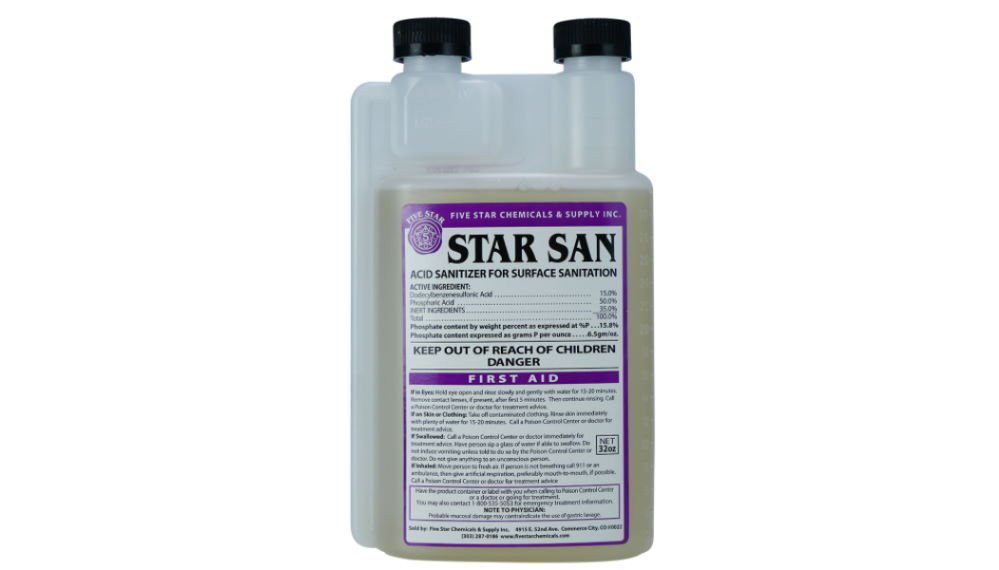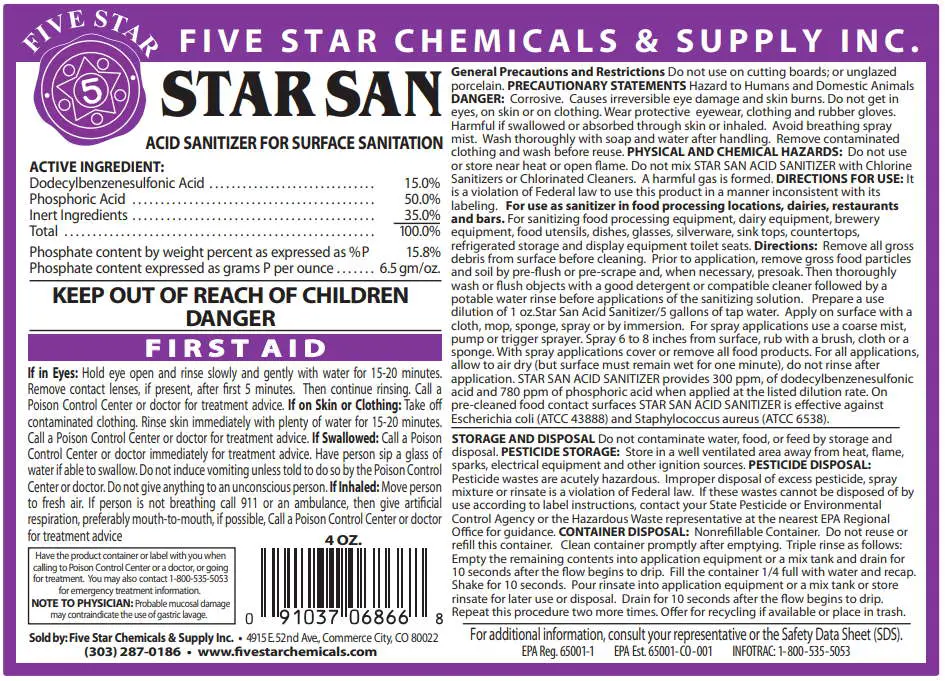The most common cause of bad-tasting homebrew is an infection caused by poor sanitation. Because of this, most homebrewers take great care to ensure that their equipment is correctly sanitised.
The most popular sanitiser for home brewing is Star San by Five Star Chemicals. Star San is a no-rinse sanitiser that won’t taint your homebrew’s taste and doesn’t kill the yeast.

The instructions on the bottle tell you to mix one ounce of Star San with five gallons of water and then apply it to your brewing equipment using cloth, mop sponge spray, or immersion.
Unfortunately, the instructions don’t mention how long you should apply the mixture to your brewing equipment. This leads many new brewers to ask, “How long does Star San take to sanitise?”
Star San takes thirty seconds to sanitise home brewing equipment. Star San is a contact sanitiser which means you don’t need to immerse everything fully. Simply spray all surfaces generously, and then wait a minute or two until the excess sanitiser has drained off.
I mix half an ounce of Star San with ten litres (two and a half gallons) of water in my fermenting vessel before putting the lid on and swilling the mix around to ensure that all surfaces have been wetted thoroughly.
I then wait two minutes before pouring most of the Star San solution into a large plastic basin where I soak the rest of my homebrew equipment. I also pour one litre of the solution into a plastic spray bottle which I use to quickly sanitise things as needed.

Why is sanitation so crucial in home brewing?
Sanitation is important because it kills the bacteria which cause the majority of off flavours in beers.
Once the wort has stopped boiling and started to cool, it is vulnerable to bacterial infection. Because of this, everything which comes into contact with the wort after the boil must be sanitised.
This includes the fermentation vessel, immersion chiller, metal spoons, hydrometer, sample tube, thermometer, auto-siphon, bottles, airlock, crown caps, etc.
Some homebrewers, myself included, even go as far as spraying the outside of the yeast packet with sanitiser just to be on the safe side.
How does Star San work?
Star San contains food-grade phosphoric acid, which effectively kills bacteria and won’t taint your beer.
Star San is non-toxic and tasteless when correctly diluted, meaning that there’s no need to rinse it off. In fact, rinsing Star San off with water will contaminate your newly sanitised equipment since there are bacteria in tap water!
You should be careful when handling undiluted Star San since it is an acid and will damage work surfaces and soft metals such as aluminium.
The label on the bottle and the product spec sheet, which can be downloaded from the Five Star website, contains all sorts of health and safety warnings about the potential dangers. This is because Star San is an industrial-grade sanitiser that is widely used in the food industry in large quantities.
As long as you store the bottle carefully and use the built-in dosing mechanism to mix it with water, you don’t need to be anymore concerned when using Star San than you do when using household bleach to clean the bathroom.
Sanitation; a two-step process
Star san does an excellent job of killing bacteria but, in order to do so, it has to come into contact with the surfaces which are to be sanitised.
This sounds obvious, right? Many people overlook the fact that, before sanitising, you first have to clean everything to remove any organic residue that would prevent the sanitiser from doing its job.
This is especially true with fermenters, bottles, and kegs which can become caked with dried on residues from the fermenting process, the yeast cake, and krausen.
At the end of each brew day, and after transferring the beer from the fermenter to bottles, I thoroughly wash everything with warm soapy water. Then, on the next brew day, I wash everything once again before sanitising.
You can purchase Powdered Brewery Wash which is specially designed for this purpose, but dish soap will also get the job done. Be sure to rinse everything thoroughly afterwards. Generally speaking, environmentally friendly brands are more suitable since they are less fragrant.
Since I bottle my beer and re-use the bottles, I also make sure that I rinse the bottles out as soon as possible after pouring the beer. It’s a lot easier to clean the yeast residue from the bottom of the bottle while it’s still wet.
Sanitation VS Sterilization, what’s the difference?
The terms sanitisation and sterilisation are often confused. Indeed, some people use the words interchangeably.
Sterilisation is the process of killing all living organisms. For example, the scalpels and other tools that a surgeon uses are sterilised before using an expensive piece of equipment called an autoclave.
Sanitisation kills approximately 99% of bacteria and other harmful bugs and is more than good enough when home brewing.
Star San Alternatives, how else can I sanitise my equipment?
As mentioned at the start of this post, star San is probably the most popular sanitiser for home brewing, but there are alternatives available.
OXIpron
OXIpron is another popular no-rinse sanitiser similar to Star San. I’ve also used OXIpron quite a lot, and in my experience, it sanitises everything just as well as Star San and can be used in the same way.
The only disadvantage that I’m aware of is that OXIpron comes in crystal form and is slightly harder to mix since you have to dissolve the crystals in water.
Iodophor
Iodophor is another no-rinse sanitiser that uses chlorine to kill bacteria. The main disadvantage of Idophor is that it takes longer to sanitise (recommended contact time = 10 minutes) and stains plastic fermentation buckets brown.
Another thing that concerns me about Idophor is that it contains iodine, which affects thyroid gland function. Although the concentration used for sanitisation is so low that it shouldn’t be a problem, I prefer not to use it just in case.
Bleach
If you are on a really tight budget, you could theoretically sanitise your brewing equipment by soaking it for twenty minutes in a dilute bleach solution.
The big disadvantage of bleach is that it contains chlorine which, if you don’t rinse it off thoroughly, will both spoil that taste of your beer and kill the yeast!
Heat
Another cheap way to sanitise homebrew equipment is by boiling it for sixty minutes.
The main disadvantage with using heat is that glassware becomes fragile when hot and is susceptible to cracking due to sudden temperature changes.
You also have to take care not to burn or scald yourself, although it might be a convenient way to sanitise your bottles and glass fermenter if you have a dishwasher that is large enough.
